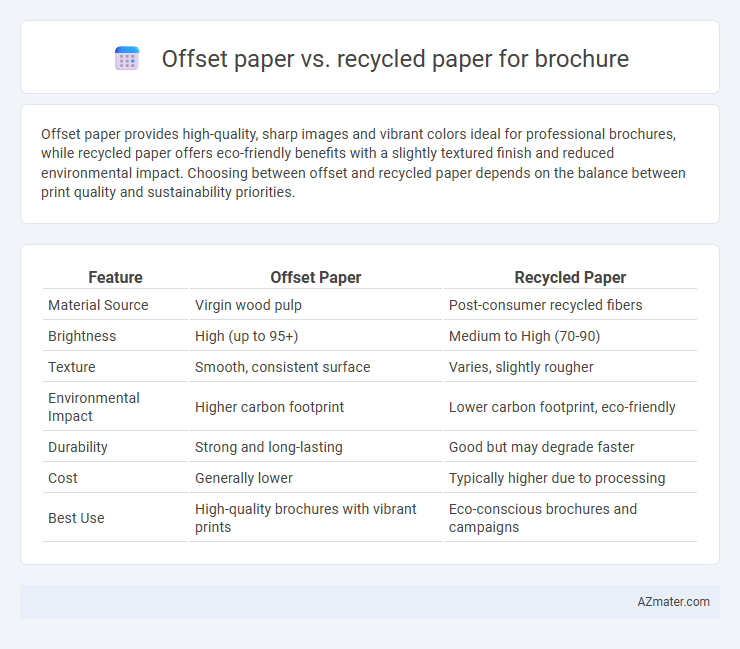Offset paper provides high-quality, sharp images and vibrant colors ideal for professional brochures, while recycled paper offers eco-friendly benefits with a slightly textured finish and reduced environmental impact. Choosing between offset and recycled paper depends on the balance between print quality and sustainability priorities.
Table of Comparison
| Feature | Offset Paper | Recycled Paper |
|---|---|---|
| Material Source | Virgin wood pulp | Post-consumer recycled fibers |
| Brightness | High (up to 95+) | Medium to High (70-90) |
| Texture | Smooth, consistent surface | Varies, slightly rougher |
| Environmental Impact | Higher carbon footprint | Lower carbon footprint, eco-friendly |
| Durability | Strong and long-lasting | Good but may degrade faster |
| Cost | Generally lower | Typically higher due to processing |
| Best Use | High-quality brochures with vibrant prints | Eco-conscious brochures and campaigns |
Introduction: Choosing Paper for Brochure Printing
Selecting the right paper for brochure printing significantly impacts visual appeal and environmental footprint. Offset paper offers superior brightness and smooth surface, ideal for high-quality color reproduction. Recycled paper supports sustainability goals by reducing waste and conserving resources, though it may have a slightly textured finish.
What is Offset Paper?
Offset paper is a high-quality, uncoated paper designed specifically for offset printing, offering smooth surfaces that ensure sharp image reproduction and vibrant colors. It typically contains a higher brightness level and is manufactured to withstand the mechanical pressure of offset printing presses, resulting in precise detail and a professional finish. This makes offset paper ideal for brochures requiring crisp graphics and bold text, contrasting with recycled paper which may have lower brightness and slight texture variations.
What is Recycled Paper?
Recycled paper is made from recovered paper fibers that are processed and transformed into new sheets, reducing the demand for virgin wood pulp and minimizing environmental impact. Unlike offset paper, which is primarily produced from freshly harvested wood fibers, recycled paper supports sustainability by conserving natural resources and reducing landfill waste. Its use in brochures promotes eco-friendly branding while maintaining print quality suitable for detailed graphics and text.
Visual Quality: Offset vs Recycled Paper
Offset paper offers superior visual quality for brochures with sharper image reproduction, vibrant colors, and smoother texture, enhancing overall print clarity. Recycled paper tends to have a rougher surface and muted tones due to the fiber content, which can slightly diminish image sharpness and color vibrancy. For high-end brochure projects where crisp visuals and color accuracy are critical, offset paper is generally the preferred choice over recycled paper.
Print Performance and Color Vibrancy
Offset paper delivers superior print performance with its smooth surface and consistent ink absorption, making it ideal for crisp, high-resolution images and sharp text, essential for professional brochures. Recycled paper often has a rougher texture and less uniform coating, which can result in slightly muted colors and less vibrant prints, affecting overall brochure impact. For vibrant color reproduction and detailed graphics, offset paper remains the preferred choice, while recycled paper offers an eco-friendly alternative with modest trade-offs in print quality.
Texture and Tactile Differences
Offset paper features a smooth, uniform texture ideal for high-quality brochure printing, offering a crisp tactile experience with a slight matte finish that enhances color vibrancy. Recycled paper often presents a more varied, natural texture with visible fibers and a softer, earthier feel, contributing to an eco-friendly and tactile authenticity. These texture and tactile differences influence the overall perception of the brochure's quality and environmental impact.
Environmental Impact Comparison
Offset paper production involves using virgin fibers with higher energy and water consumption, resulting in greater carbon emissions compared to recycled paper. Recycled paper significantly reduces deforestation and landfill waste, lowering overall environmental footprint by conserving natural resources and requiring less energy in manufacturing processes. Choosing recycled paper for brochures supports sustainable practices through reduced pollution and a smaller ecological impact.
Cost Considerations
Offset paper offers a lower cost per unit due to its mass production and widespread availability, making it a budget-friendly choice for large print runs of brochures. Recycled paper typically incurs higher expenses because of the additional processing required to repurpose fibers, which can increase the overall printing cost. Businesses must weigh the cost savings of offset paper against the eco-friendly appeal and potential marketing value of using recycled paper in their brochure campaigns.
Suitability for Different Brochure Types
Offset paper offers a smooth finish and vibrant print quality, making it ideal for high-end brochures such as luxury product catalogs and corporate presentations where color accuracy and sharp images are crucial. Recycled paper is suitable for eco-friendly or informational brochures that prioritize sustainability and appeal to environmentally conscious audiences but may have a slightly rougher texture and less vivid color reproduction. Choosing between offset and recycled paper depends on the desired visual impact and the target audience's values, with offset paper favored for premium visuals and recycled paper for green messaging.
Final Thoughts: Which Paper is Best for Your Brochure?
Offset paper offers superior print quality with vibrant colors and sharp details, ideal for high-impact brochures that demand professionalism and visual appeal. Recycled paper provides an eco-friendly alternative, reducing environmental impact while maintaining acceptable print quality for brands prioritizing sustainability. Choose offset paper for premium presentation or recycled paper to align with green values and promote corporate responsibility.

Infographic: Offset paper vs Recycled paper for Brochure
 azmater.com
azmater.com